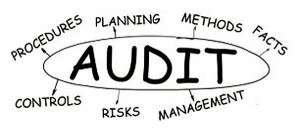How Do You Conduct a Cybersecurity Audit?

Cybersecurity is a vital concern for individuals and organizations alike, as cyber attacks continue to rise and threaten sensitive information. Conducting a thorough cybersecurity audit can help identify vulnerabilities and protect against potential threats. In this article, learn the steps you need to take to conduct a successful cybersecurity audit and safeguard your digital world. How Do You Conduct a Cybersecurity Audit?
What Is a Cybersecurity Audit?
A cybersecurity audit is a thorough evaluation of an organization’s information systems, policies, and procedures in order to identify any vulnerabilities and ensure compliance with security standards. This process includes reviewing network configurations, access controls, data encryption methods, and security incident response plans. The ultimate goal of the audit is to safeguard sensitive data, prevent unauthorized access, and mitigate potential cybersecurity risks.
Cybersecurity is a vital concern for individuals and organizations alike, as cyber attacks continue to rise and threaten sensitive information. Conducting a thorough cybersecurity audit can help identify vulnerabilities and protect against potential threats. In this article, learn the steps you need to take to conduct a successful cybersecurity audit and safeguard your digital world.
Regularly conducting audits allows organizations to identify weaknesses, implement necessary safeguards, and enhance their overall security measures. By staying proactive with cybersecurity audits, organizations can stay ahead of evolving threats and ensure the confidentiality, integrity, and availability of their digital assets.
Why Is a Cybersecurity Audit Necessary?
A cybersecurity audit is essential in safeguarding sensitive data and defending against cyber threats. It serves to identify vulnerabilities, evaluate the effectiveness of security measures, and ensure compliance with regulations. By conducting regular audits, organizations can proactively detect and mitigate potential risks, preventing data breaches and financial losses. Furthermore, audits provide valuable insights into areas that require improvement, enabling the implementation of stronger security controls.
To ensure a successful cybersecurity audit, it is recommended to:
- Appoint a dedicated team
- Utilize automated tools
- Stay updated with industry best practices
- Regularly review and update security policies and procedures
What Are the Steps Involved in Conducting a Cybersecurity Audit?
In today’s digital landscape, cybersecurity is a crucial aspect for any organization to consider. One way to ensure the safety and integrity of sensitive information is through conducting a cybersecurity audit. This section will discuss the step-by-step process of conducting a cybersecurity audit, from defining the scope and objectives to analyzing and reporting the findings. By understanding the key steps involved, organizations can better protect themselves from potential cyber threats.
1. Define the Scope and Objectives
A cybersecurity audit begins with clearly defining the scope and objectives to ensure a focused and effective assessment. Here are the steps involved in this crucial phase:
- Identify the systems, networks, and assets that will be included in the audit.
- Establish the goals and desired outcomes of the audit, such as identifying vulnerabilities, assessing compliance, or evaluating incident response capabilities.
- Define the time frame and resources allocated for the audit.
- Clarify the roles and responsibilities of the audit team and stakeholders.
Pro-tip: Defining the scope and objectives of a cybersecurity audit is crucial as it helps to set expectations, allocate resources effectively, and ensure that the audit addresses the specific goals of the organization.
2. Identify Key Assets and Risks
Identifying key assets and risks is a crucial step in conducting a cybersecurity audit. Here is a list of steps to follow:
- Identify all digital assets: This includes hardware, software, networks, and data.
- Assess asset value: Determine the importance and sensitivity of each asset to prioritize protection efforts.
- Identify potential risks: Analyze potential threats such as malware, unauthorized access, data breaches, and physical damage.
- Analyze vulnerabilities: Identify weaknesses in security controls and processes that could be exploited by attackers.
- Prioritize risks: Evaluate the likelihood and potential impact of each risk to prioritize mitigation strategies.
- Document findings: Create a comprehensive report detailing the identified assets, risks, and recommended actions for improvement.
3. Assess Current Security Measures
To properly assess the current security measures during a cybersecurity audit, it is important to follow these steps:
- Review Security Policies: Take a close look at the existing policies and procedures to ensure that they are in line with industry best practices.
- Inspect Infrastructure: Evaluate the design and implementation of the organization’s network, hardware, and software systems.
- Analyze Access Controls: Evaluate the effectiveness of the authentication, authorization, and accounting mechanisms in place.
- Test Security Controls: Conduct vulnerability scans and penetration tests to identify any weaknesses or potential exploits.
- Monitor Incident Response: Assess the organization’s ability to detect, respond, and recover from any security incidents.
During a cybersecurity audit, an organization discovered that their security controls were outdated, leaving their system vulnerable to attacks. By carefully assessing their current security measures, they were able to identify the weaknesses and take immediate action to strengthen their defenses, preventing potential breaches and safeguarding their sensitive data.
4. Conduct Vulnerability and Penetration Testing
Conducting vulnerability and penetration testing is a crucial step in a cybersecurity audit. This process helps identify any weaknesses or vulnerabilities in a company’s systems and networks that could be exploited by hackers. Here are the steps involved in conducting the necessary testing:
- Perform a comprehensive scan of all systems and networks to identify potential vulnerabilities.
- Test the identified vulnerabilities by simulating real-world hacking techniques.
- Exploit the vulnerabilities to gain unauthorized access to systems and data.
- Evaluate the impact of the successful exploits and assess the potential risks.
- Provide detailed reports on the vulnerabilities found, along with recommendations for mitigation and remediation.
By conducting vulnerability and penetration testing, organizations can proactively identify and address security weaknesses, ensuring the protection of their systems and sensitive data.
5. Analyze and Report Findings
During the process of conducting a cybersecurity audit, analyzing and reporting findings is a crucial step. This involves assessing the collected data and presenting it in a comprehensive report. Here are the steps involved in analyzing and reporting findings:
- Review collected data: Analyze the data collected during the audit, including results from vulnerability and penetration testing, security logs, and incident reports.
- Identify patterns and trends: Look for common vulnerabilities, recurring security incidents, or any emerging threats.
- Evaluate impact and risk: Assess the potential impact of the identified vulnerabilities and risks on the organization’s systems, data, and operations.
- Rank findings: Prioritize the identified vulnerabilities and risks based on their severity and likelihood of exploitation.
- Provide recommendations: Offer actionable suggestions to address the identified issues, including specific security controls and measures to mitigate risks.
- Create a detailed report: Document all the findings, analyses, rankings, and recommendations in a comprehensive and easily understandable report format.
- Present the report: Present the findings and recommendations to relevant stakeholders in a clear and concise manner, highlighting the potential impact and the importance of taking immediate action.
What Are the Common Challenges in Conducting a Cybersecurity Audit?
Despite the growing importance of cybersecurity audits, many organizations still face challenges in conducting them effectively. In this section, we will discuss the common hurdles that companies encounter when attempting to perform a thorough cybersecurity audit. From limited resources to resistance to change, these challenges can hinder the success of an audit and leave organizations vulnerable to cyber threats. Let’s dive into the four main obstacles that companies must navigate when conducting a cybersecurity audit.
1. Lack of Resources
A lack of resources can present a significant challenge when conducting a cybersecurity audit. However, there are steps that can be taken to mitigate this issue:
- Prioritize: Identify critical areas and allocate resources accordingly.
- Automation: Utilize automated tools and technologies to streamline the audit process and reduce the need for manual labor.
- Training: Provide training to existing staff to enhance their knowledge and skills in cybersecurity auditing.
- Outsourcing: Consider outsourcing certain aspects of the audit to specialized cybersecurity firms if resources are limited.
- Collaboration: Foster collaboration between different teams within the organization to pool resources and expertise.
2. Difficulty in Identifying All Assets and Risks
Identifying all assets and risks during a cybersecurity audit can be a daunting task, but following a systematic approach can make it easier. Here are the steps to overcome this challenge:
- Establish a comprehensive inventory of all assets, including hardware, software, and data.
- Conduct a thorough risk assessment to identify potential vulnerabilities and threats.
- Engage with key stakeholders, such as IT teams and department heads, to gather insights on assets and risks.
- Utilize automated tools and technologies to assist in asset discovery and risk identification.
- Regularly update and maintain the asset and risk register to capture any changes or additions.
Pro-tip: Collaborate with different departments to gain a holistic view of the organization’s assets and risks, ensuring a more accurate and comprehensive cybersecurity audit.
3. Limited Expertise and Knowledge
Limited expertise and knowledge can present challenges during a cybersecurity audit. To overcome these obstacles, follow these steps:
- Educate the team: Provide training and resources to enhance knowledge and skills in the field of cybersecurity.
- Engage external experts: Collaborate with specialists who possess the necessary expertise and experience to assist with the audit.
- Stay updated: Continuously stay informed about the latest cybersecurity trends, threats, and best practices to ensure the audit is thorough and effective.
- Utilize tools and technologies: Leverage automated tools and technologies to assist in identifying vulnerabilities and assessing security measures.
- Establish partnerships: Build relationships with industry experts, organizations, and forums to gain insights and guidance during the audit process.
By following these steps, organizations can mitigate the impact of limited expertise and knowledge, ensuring a successful cybersecurity audit.
4. Resistance to Change
Resistance to change is a common challenge that often arises during a cybersecurity audit. This resistance can stem from various reasons, such as fear of disruption, lack of awareness, or reluctance to adopt new security measures. Effectively addressing this resistance requires utilizing effective communication and change management strategies. This can include engaging with stakeholders, providing training and education, and emphasizing the benefits of improved cybersecurity. Additionally, involving employees in the decision-making process and addressing their concerns can help cultivate a culture of security and facilitate a smoother transition. Ultimately, overcoming resistance to change is crucial for the success of a cybersecurity audit.
How Can You Ensure the Success of a Cybersecurity Audit?
A cybersecurity audit is a crucial tool for organizations to assess and improve their security measures. However, conducting a successful audit requires careful planning and execution. In this section, we will discuss the key steps that can ensure the success of a cybersecurity audit. From setting clear objectives and involving all relevant stakeholders to using a comprehensive framework and addressing identified issues, each step plays a critical role in the overall effectiveness of a cybersecurity audit. Let’s dive in and explore these steps in more detail.
1. Have Clear Objectives and Scope
Having clear objectives and scope is essential for a successful cybersecurity audit. To ensure clarity, follow these steps:
- Define the purpose: Clearly state the goals and objectives of the audit to align with the organization’s needs.
- Identify the scope: Determine which systems, networks, and assets will be included in the audit.
- Establish criteria: Set measurable criteria for evaluating security controls and practices.
- Engage stakeholders: Involve all relevant parties to gain insights and address concerns.
- Document expectations: Clearly communicate the scope, objectives, and timeline to all involved parties.
To further enhance the effectiveness of the cybersecurity audit, consider the following:
- Regularly review and update objectives to adapt to changing threats and technologies.
- Ensure open communication and collaboration among all stakeholders.
- Utilize established frameworks and best practices to guide the audit process.
- Promptly address any identified issues to mitigate risks and improve the overall security posture.
2. Involve All Relevant Stakeholders
Involving all relevant stakeholders is crucial for the success of a cybersecurity audit. This ensures that all perspectives and expertise are taken into account, leading to a comprehensive assessment of the organization’s security measures. Here are the steps to effectively involve all stakeholders:
- Identify key stakeholders, including IT personnel, management, legal, and HR.
- Communicate the purpose and importance of their involvement in the audit.
- Conduct interviews or workshops to gather insights and input from all stakeholders.
- Share audit findings and recommendations with stakeholders for their review and feedback.
- Involve all stakeholders in the implementation of recommended security measures to ensure buy-in and cooperation.
True story: In a recent cybersecurity audit, involving all relevant stakeholders resulted in the discovery of a critical vulnerability that had been overlooked. The input from various departments allowed for a comprehensive understanding of the organization’s security landscape, leading to effective measures to address the vulnerability and enhance overall cybersecurity.
3. Use a Comprehensive and Proven Framework
To guarantee the success of a cybersecurity audit, it is essential to follow a comprehensive and proven framework. Here are the recommended steps to take:
- Define the scope and objectives of the audit.
- Identify key assets and risks that require assessment.
- Evaluate the current security measures in place.
- Conduct vulnerability and penetration testing to identify any potential weaknesses.
- Analyze the results and accurately report them.
Pro-tip: When selecting a framework, it is wise to consider established standards such as the NIST Cybersecurity Framework or ISO 27001. These provide a structured approach for evaluating and enhancing cybersecurity practices, ensuring a thorough and effective audit.
4. Address Any Identified Issues Promptly
Addressing any identified issues promptly is crucial in a cybersecurity audit to ensure the security and integrity of an organization’s systems and data. Here are steps to address identified issues promptly:
- Identify the severity of the issue and prioritize it based on its potential impact.
- Allocate the necessary resources, including time, personnel, and budget, to fix the issue.
- Develop an action plan with specific tasks and deadlines to address the issue.
- Implement the necessary fixes, such as patching vulnerabilities or updating security measures.
- Test the implemented fixes to verify their effectiveness.
- Monitor and evaluate the changes to ensure the issue has been successfully resolved.
Conduct a Cybersecurity Audit
In a similar tone, a true story highlights the importance of addressing issues promptly. XYZ Company experienced a data breach due to an unpatched vulnerability. However, by promptly addressing the issue, applying necessary patches, and bolstering their cybersecurity measures, they successfully prevented further breaches and safeguarded their sensitive information.
Frequently Asked Questions
What is a cybersecurity audit and why is it important?
A cybersecurity audit is a process of assessing an organization’s security measures, identifying potential vulnerabilities, and making recommendations for improvement. It is important because it helps protect sensitive information and prevent security breaches that can result in financial loss and damage to an organization’s reputation.
How do you prepare for a cybersecurity audit?
To prepare for a cybersecurity audit, you should first create a detailed inventory of your organization’s digital assets, including hardware, software, and data. You should also review your security policies and procedures, and ensure that all employees are aware of and following them. It is also recommended to conduct a vulnerability assessment to identify potential risks.
What are the steps involved in conducting a cybersecurity audit?
The steps involved in conducting a cybersecurity audit include identifying the scope and objectives of the audit, gathering information and documentation, assessing the effectiveness of current security measures, identifying vulnerabilities and risks, making recommendations for improvement, and creating an action plan to address any identified issues.
What tools and techniques can be used to conduct a cybersecurity audit?
There are various tools and techniques that can be used to conduct a cybersecurity audit, such as vulnerability scanners, penetration testing, social engineering tests, and automated audit tools. It is also important to use a combination of manual and automated methods to ensure a thorough assessment.
Who should conduct a cybersecurity audit?
A cybersecurity audit can be conducted by internal personnel or external consultants who have specialized knowledge and experience in cybersecurity. It is important to choose someone who is unbiased and not involved in the day-to-day security operations of the organization.
How often should a cybersecurity audit be conducted?
The frequency of conducting a cybersecurity audit depends on various factors such as the size and nature of the organization, the industry it operates in, and any regulatory requirements. However, it is generally recommended to conduct a cybersecurity audit at least once a year, or whenever there are significant changes to the organization’s systems or processes.t response plans. The ultimate goal of the audit is to safeguard sensitive data, prevent unauthorized access, and mitigate potential cybersecurity risks.
Regularly conducting audits allows organizations to identify weaknesses, implement necessary safeguards, and enhance their overall security measures. By staying proactive with cybersecurity audits, organizations can stay ahead of evolving threats and ensure the confidentiality, integrity, and availability of their digital assets.
















Excellent article, will appreciate if a pdf copy can be mailed to
[email protected]
I am a Management Systems Consultant.
Hi Ananthraman – Happy that you’re loving the article. You can press Ctrl+P or Cmd+P on the internet browser while having the article up to easily save a PDF copy.
Great job. Pls keep it up